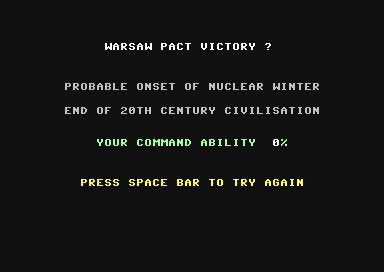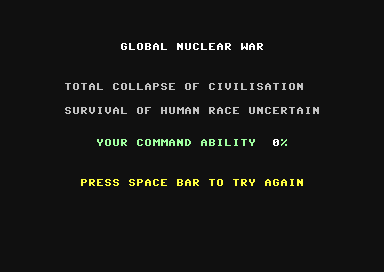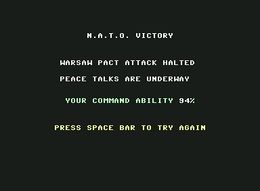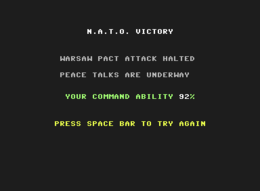Theatre Europe
| Theatre Europe | ||
|---|---|---|
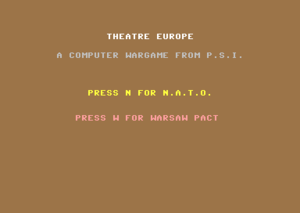 | ||
| Game No. | 472 | |
| Voting | 7.50 points, 20 votes | |
| Developer | Alan Steel, Sean Pearce, David Bolton | |
| Company | Personal Software Services (PSS) | |
| Publisher | Personal Software Services (PSS), Datasoft (USA), ERE Informatique (France) | |
| Musician | David Dunn | |
| HVSC-File | MUSICIANS/D/Dunn_David/Theatre_Europe.sid | |
| Release | 1985 | |
| Platform | C64, ZX Spectrum, Amstrad CPC, MSX, Atari 8-bit, Apple II, Tatung Einstein, Amiga, JaC64 | |
| Genre | Strategy, Shoot'em Up, War | |
| Gamemode | Single player | |
| Operation | ||
| Media | ||
| Language | ||
| Information | Called Europe war on bootleg editions and Conflict: Europe on the Amiga port | |
Description[edit | edit source]
Background[edit | edit source]
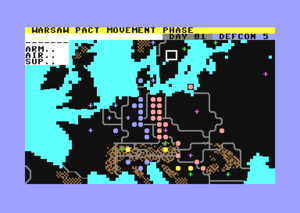
Theatre Europe is a British video game released in 1985. It's a turn-based strategy game with optional shoot'em up screens. It was ported in many systems of the time and received positive reviews. The publisher, Personal Software Services, specialized in strategy games, and wrote several titles with similar gameplay and graphics.
The game tries to simulate a world war between NATO and the Warsaw Pact during the 80s, and feature conventional battles as well as NBC weapons. The game is single player: the human player can chose one of the two sides and the computer will command the other side. For the Warsaw Pact, the objective is to advance with several divisions beyond the Rhine within 29 in-game days, while NATO has to prevent this. If the player launches a total nuclear attack, the computer opponent will always retaliate and this will lead to mutual annihilation. Imminent conventional defeat or repeated use by either side of NBC weapons may prompt the computer to launch a total nuclear attack, and if the player's reflex system is on, he will automatically retaliate and this will lead to mutual annihilation; if the player's reflex system is off, retaliation to such attack is not possible and the computer will win.
During development, PSS inquired about the actual military strength fielded in Europe, and contacted Soviet and British institutions for information. The coders eventually discovered that communist forces where vastly superior and wondered if it would have been possible to write a playable game. Eventually, balance was reached by downsizing Russian forces and by providing the computer with very crude instructions to guide its moves. Playing on the Warsaw Pact side is quite easy, while winning as NATO is somewhat challenging and it's possible only because the computer doesn't play as well as a human player would.
Upon release, the game created some controversy in England and Finland, where sale of the game was seen as a provocation to the Soviet Union and criticised in the parliament. The game was relatively popular in Eastern Europe in the 80s and has been translated into Spanish and Italian.
The game was notable because, in order to access certain options, players were required to insert a password. The password wasn't provided in-game or in the manual; instead, the player was instructed to call a number. The number, available only in the United Kingdom at the time of game's release, connected the caller with a recorded message. After sounds effects of screams and explosions, the message disclosed the password to access strategic nuclear options was "midnight sun".
The opening and ending screen of the game greet the player with an electronic version of "Give Peace a Chance" by John Lennon.
Starting options[edit | edit source]
Before beginning the game, the player has to choose between some options:
- Choosing a side - NATO is the blue army on the left, Warsaw-Pact is the red army on the right. The human player always plays first.
- Difficulty level - 1 is the easiest, 3 the more difficult. Difficult levels will render enemy units tougher and will make the computer player more prone to use NBC weapons. Repeated use of those will lead to nuclear holocaust and will end the game.
- Action screens - Action screens are a mini-game where the player tries to shoot and destroy enemy vehicles. The player performance will affect this turn's battles.
- Reselect - The starting menu offers the possibility to reselect the game options, but later in-game choices are often irreversible. Loading a saved game, or, once the game started, saving a match halfway, is not possible with most emulators, and trying it will cause the program to crash.
Gameplay[edit | edit source]
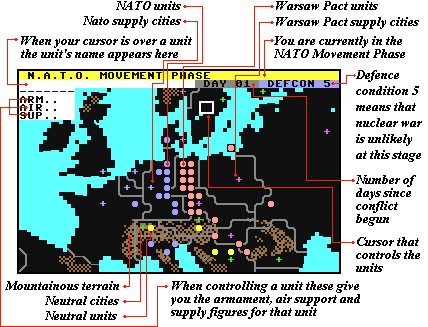
When the game starts the player is presented with the following screen:
The game is played in turns and lasts a maximum of 15 turns. The human player always starts the game and then the computer plays. After both players ended their turn, the game advances two in-game days. Every turn is divided in phases:
- Troop movements - Every unit, equivalent to real life corps or divisions, can move to any free adjacent land square. Moving to a mountain square will prevent the unit to move again during the next turn. The Warsaw Pact has an amphibious unit that can move through water, but once it lands it can move only through land. If it sails beyond the Danish Strait, NATO navy will automatically sink it once it reaches two squares North of Copenhagen. The Warsaw Pact also has an airborne unit that can parachute on a portion of the map. Its first move counts as a flight whatever its length, after it parachutes it can move only through land, and can be resupplied only with air cover. Neutral units never move.
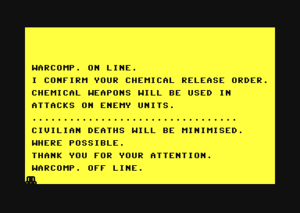
- Chemical release order - Each side can authorise its units to use tactical chemical weapons. Use of such weapons increase the damage caused in battle. The order can be given once per game and it's irreversible. If the player gives the order first, the computer will surely do the same during its turn or the next. If the computer gives the order first, the player better do the same. Use of chemical weapons raises the Defcon level, increasing the odds for the computer to launch a total nuclear attack. Defcon 5 is the lower level, Defcon 2 is the maximum that can be reach in-game, because Defcon 1 will trigger a total nuclear attack and the game will end.
- Bombing - If the game is set on difficulty 2 or 3 and the player have enough resources allocated to the assault-breaker ability (see below), then it's possible to bomb one enemy unit before the attack.
- Attack - Every unit can attack an enemy unit beside it. The amphibious unit can attack only if it's on land. Defending units receive a combat bonus. Units defending on a mountain square receive a bigger bonus. A battle will cause damage to both the attacker(s) and the defender. The damage is calculated comparing the balance of power between attacker(s) and defender, multiplied by a random factor and, eventually, the result of the action screen.
- Action screen - Whether is the player's or the computer's turn, in case of battle the player can choose to play the action mini-game. If the player is NATO and on this turn the Warsaw Pact decided to attack only neutral units, the choice of selecting a battle is still given, but the player can't actually select a battlefield and can only press the space bar to skip the phase. When the player selects a battle, he will see that the action takes place on a field, a mountain or a city. The scenery is chosen between the kinds of terrain the various units involved in a battle are, but doesn't affect the gameplay or the results. How good the player fares on the screen will affect the whole front. During the action the player can shoot at three different classes of vehicles: tanks and anti-air armour in the lower section that move left and right; tanks and self-propelled artillery that slowly move closer, farther, left or right in the central section; and finally, jets and helicopters that fly left or right up in the sky. Is not obvious nor explained, but the lower vehicles are allies, that the player should avoid to shoot. Destroying them doesn't seem to penalize the player, but prevents him to score kills among the enemies.
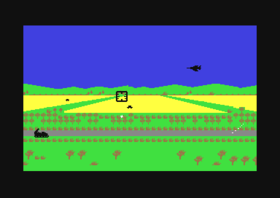 |
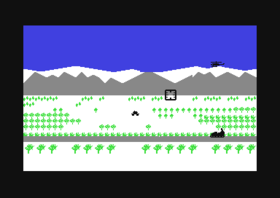 |
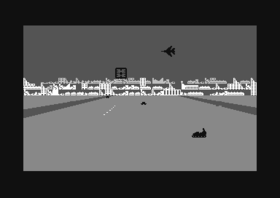 |
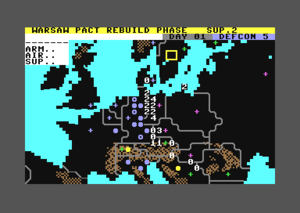
- Rebuild - Every unit has three values: armour (arm), counter air (air) and air superiority (sup). Armour allows to damage other units' armour during land combat. It's the basic strength of a unit, the other two are secondary. If it falls to zero, the unit is destroyed, unless it's due to aerial bombing only, in which case the unit survives but in a precarious state. Counter air allows to damage other units' air superiority land during combat. Air superiority allows to a unit to resist a targeted bombing or strategic interdiction. During the rebuild phase a number of reinforcements are available each turn to distribute among the different units. If not assigned, these reinforcements are lost.
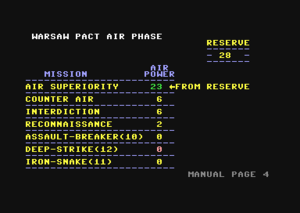
- Air phase - During the air phase a number of reinforcements are available to allocate to different strategic missions. There are seven missions: air superiority, counter air, interdiction, reconnaissance, assault-breaker, deep-strike and iron-snake. This section is quite tricky. In theory a player can allocate reinforcements from the strategic reserve to specific missions and vice-versa, but in reality the game design prevents it. To begin with, a player can send air units to the front at the beginning of the phase, and only after he can withdraw from the front air units and place them in reserve. He can't reassign those withdrawn units until the next turn, which means they will be idle the whole turn. On top of that, every figure shown diminishes in between turns, perhaps to represent the attrition sustained in combat. But for some reason the figure of units kept in reserve lowers too, which means keeping units there is twice as dumb. When the reserve has no units, no unit can disappear from there which, oddly enough, means being at the front is safer than being on the rear-guard. Every turn there is a chance new units will be available in the reserve, perhaps to represent newly built or reconditioned hardware. But again, this will happen only if the previous number was zero. All of this makes that the best choice is to allocate all reserves at once, never recall units from duty, and keep sending to the front planes as soon as they are available.
- Air superiority allows to defend from the enemy's offensive air missions. It's by far the most important aspect of air combat.
- Counter air allows to attack the enemy's air forces.
- Interdiction allows to attack enemy reinforcements in transit to the front, or, in other words, to deny land reinforcements to the enemy.
- Reconnaissance allows to see the current strength of enemy units on the main map.
- Assault-breaker is the ability to bomb a specific enemy unit before the attack phase. It's available only if its value is higher than 10, any inferior value it's useless.
- Deep-strike and iron-snake are supposed to be interdiction missions, but the high requirements and the little effect make them quite useless.
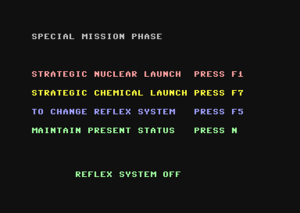
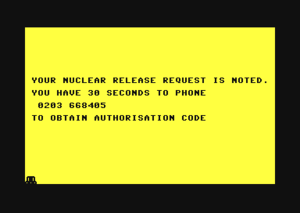
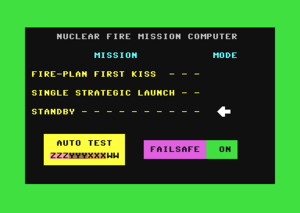
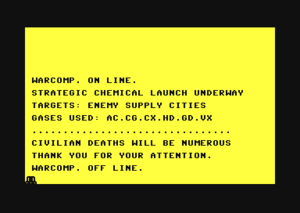
- Special mission phase - On this screen it's possible to manage the strategic nuclear and chemical arsenal. The interface is poorly designed, because different options are accessible in sub-menus but once inside them it's not possible to come back; only one choice is possible per turn; the different commands are not explained, etc. A part from the title, there are five lines, but they may be missing in certain situations.
- The strategic nuclear launch option doesn't immediately unleash an attack, but leads to a sub-menu. At first, the player is instructed to call a number, now disconnected, to retrieve a password. The password is "midnight sun" in all caps. It's necessary to insert the password only once per game. Once entered, further options are unlocked.
- The first option is called first kiss for Warsaw Pact players or warm puppy for NATO players. If the player selects this line and presses fire, he will launch a total nuclear war, the computer will retaliate, and the game will end.
- The second option, single strategic launch, will allow the player to target a single enemy city to nuke. The computer will retaliate. This doesn't seem to have any consequence other than raising the Defcon level.
- Selecting standby or pressing the space bar on any line will simply skip the phase.
- The strategic chemical launch option doesn't lead to a sub menu, but allows the player to target right away a single enemy city to gas. The game description suggests that afterwards the enemy's reinforcements will diminish. However, the chemical attack doesn't seem to have any consequence other than raising the Defcon level. It's possible to gas only one city per game: after one use the option will disappear.
- The change the reflex system option doesn't lead to any sub menu and doesn't end the phase either. It's possible to change the reflex system status unlimited times. The option, however, will start to be displayed only one turn after the password is entered in the strategic nuclear launch sub-menu.
- The last line simply indicates whether the reflex system is currently active or inactive. If active, whenever the enemy launches a single chemical attack, a single nuclear attack or an all-out nuclear attack, the player's side will automatically respond in kind. If inactive, then the game won't retaliate. Manually counterattacking is not a valid alternative, because the computer's attack won't be answered, while the player's attack will itself trigger retaliation. If the computer's attack is an all-out nuclear strike, then it's simply not possible to counterattack and the player will automatically lose the game. On the other side, whenever the system is active and the player launches on his own initiative a single chemical attack or a single nuclear attack, the computer will counterattack, and the player's side will automatically retaliate to the counterattack. On the original game the reflex system is active by default, but later crack versions deactivate it from the start.
- The strategic nuclear launch option doesn't immediately unleash an attack, but leads to a sub-menu. At first, the player is instructed to call a number, now disconnected, to retrieve a password. The password is "midnight sun" in all caps. It's necessary to insert the password only once per game. Once entered, further options are unlocked.
After the player went through all his turn's phases, the computer will do the same, until the end of the game.
Order of battle[edit | edit source]
N.A.T.O. UNIT NAME ARM AIR SUP DANISH I CORPS............ 2 1 1 DUTCH I CORPS............. 3 1 2 BELGIUM I CORPS........... 3 2 2 BRITISH I CORPS........... 4 2 3 WEST GERMANY I CORPS...... 7 3 3 WEST GERMANY II CORPS..... 7 3 3 WEST GERMANY III CORPS.... 5 2 3 UNITED STATES V CORPS..... 9 4 5 UNITED STATES VII CORPS... 8 4 5 FRENCH I CORPS............ 3 2 3 FRENCH II CORPS........... 2 1 2 ITALIAN II CORPS.......... 2 1 1 ITALIAN IV CORPS.......... 1 1 1 ITALIAN V CORPS........... 3 1 2
WARSAW PACT UNIT NAME ARM AIR SUP 3rd SHOCK ARMY............ 9 4 4 1st GUARDS TANK ARMY...... 8 4 4 3rd GUARDS TANK ARMY...... 6 3 3 4th GUARDS TANK ARMY...... 6 3 3 8th GUARDS TANK ARMY...... 4 3 3 2nd GUARDS ARMY........... 8 4 4 8th GUARDS ARMY........... 8 4 4 20th GUARDS ARMY.......... 7 3 4 10th ARMY................. 4 2 2 16th ARMY................. 4 2 2 21st ARMY................. 3 1 2 28th ARMY................. 7 3 4 41st ARMY................. 6 3 2 1st AIRBORNE ARMY......... 3 1 1 1st AMPHIBIOUS ARMY....... 3 1 2 1st POLISH ARMY........... 5 2 2 2nd POLISH ARMY........... 4 2 2 2nd RUMANIAN ARMY......... 5 1 2 3rd RUMANIAN ARMY......... 4 1 2
NEUTRAL COUNTRIES UNIT NAME ARM AIR SUP SWISS ARMY................ 2 2 1 AUSTRIAN ARMY............. 2 1 1 YUGOSLAVIAN I CORPS....... 2 1 1 YUGOSLAVIAN II CORPS...... 2 0 1
Reinforcements schedule[edit | edit source]
N.A.T.O. DAY ARM TAC-AIR SUP AIR 1 1 1 1 0 3 4 4 6 1 5 6 6 8 3 7 1 0 4 7 9 1 2 6 6 11 1 1 8 1 13 2 4 9 1 15 2 3 8 2 17 1 1 8 2 19 3 4 9 1 21 0 1 8 1 23 1 0 4 2 25 1 3 5 0 27 1 2 4 1 29 2 1 4 1
WARSAW PACT DAY ARM TAC AIR SUP AIR 1 1 3 2 0 3 2 2 9 0 5 1 1 9 1 7 1 0 6 2 9 2 2 8 0 11 1 2 8 1 13 1 3 9 0 15 8 4 9 1 17 8 5 9 1 19 6 3 9 0 21 1 2 6 2 23 0 2 4 1 25 2 1 2 0 27 2 1 2 0 29 2 0 1 0
Design[edit | edit source]
- Simple strategic map with large use of ASCII.
- Interface with lot of info for C64 standards, very little info for strategy games standards.
- Bright colours shoot'em up mini-game.
- Several text screens with options and reports.
- Very underwhelming sub-menus.
- Annoying sound effects removed on crack versions.
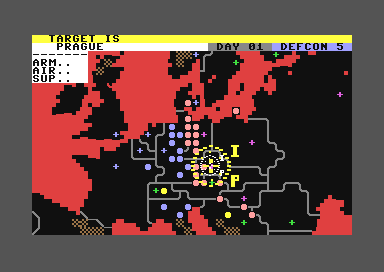 |
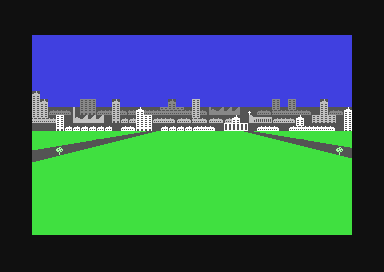 |
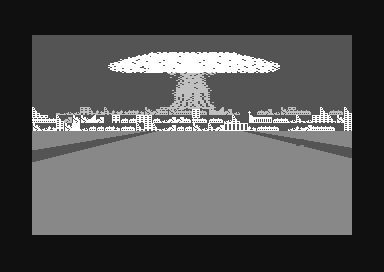 |
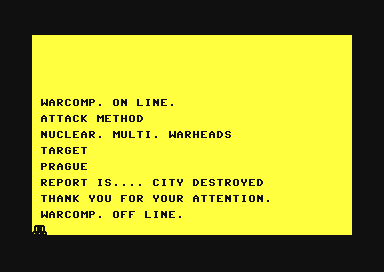 |
8-bit holocaust:
 |
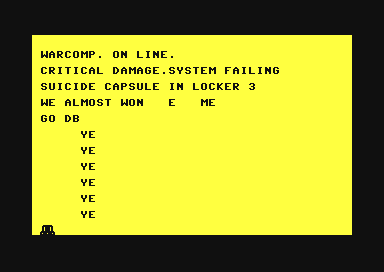 |
Hints[edit | edit source]
The game is not really difficult, but it's a strategy game so some thought is required. Many aspects of the game are not explained and many values are not displayed, so it's very useful to read the following suggestions.
- Choosing a side - NATO is more difficult to play, because it starts with far less units. Its goal is to defend West Germany, and even though the defender has a combat bonus, it is of not much use because the attacker always tries to target a single unit with many, sometimes even with the help of aerial bombing. Advancing into eastern territory or killing many enemy units doesn't seem to have any effect on the game. The goal of the Warsaw Pact is to advance with a number of units beyond the Rhine. Occupying other lands within reach, like Yugoslavia, Italy, the Alps, Denmark or Sweden, or even destroying their units, doesn't seem to have any effect on the game. On the other side, sneaking through enemy units in Germany without attacking them or, even worse, sending the airborne unit behind enemy lines and moving it further West early in the game, is something the computer takes very badly, and systematically triggers a total nuclear attack.
- Difficulty level - The game is not very different on higher difficulties. Combat is slightly harder, but only if the player skips the action scenes. The main difference is that the computer is more likely to escalate NBC warfare.
- Action screens - Action scenes are crucial. Playing well improves a lot the combat results, playing bad penalize them just as much. Over time they can become tedious and repetitive, but it's necessary to playing them to get a good score.
- Troop movements - The computer moves are fairly crude, and knowing how it behaves is helpful to counter it.
- NATO strategy - If the player controls NATO, the computer will move West all its units that are not currently in contact with the enemy; it will attack any NATO or neutral unit whenever it has a certain strength superiority; it will never swap two of its units; it will very rarely move in diagonal, only to flank a NATO unit at the edge of a front and only if it won't immediately be surrounded; it will never move its units through NATO front gaps unless they are three squares wide or more; unless one of its front units disappear it will never bring to the front its second line; it will never retreat; on occasion units won't advance anymore and will stay put until the end of the game. Its northernmost unit, the amphibious one, will reach Denmark and get stuck there unless destroyed; its airborne unit will land in Württemberg and stay there unless destroyed. The computer will try to attack with several units a single target: if two vertical fronts are in contact, it will identify weak NATO units and attack only those with two or three units, hoping to destroy units one by one. So the best strategy for the player is to create with its bests units a vertical front on a choke point. NATO has five good units: the two American ones and the three German ones; the British unit can be reinforced and place in a the second line as reserve, together with the Belgian and the Dutch units; the others are useless, except perhaps to attack in group the Soviet airborne unit. It's important to put on the front only excellent units, because weak ones will be attacked and destroyed. Because the computer won't sneak through gaps in fear of being surrounded and attacked in group, the player can space them to cover the whole front from the Baltic to the Adriatic like in the picture below. A more solid alternative is to retreat to the Rhine, like on the other picture below. This retreat will limit the number of turns Soviet forces are in contact and therefore can attack western armies, will make use of the Swiss army as the southernmost flank, reduce the length of the front and therefore the number of units the Russians can use to attack. Losing Italy, the Alps, Denmark or land east of the Rhine doesn't affect the victory conditions, so defending them is purely a cosmetic choice. Whenever a unit is badly damaged, it tries to retreat, and if it can't because the square to the West is occupied or it's made of water, then the damage increases. It's therefore a good idea to place the second line behind the gaps on the front, like show in the maps.
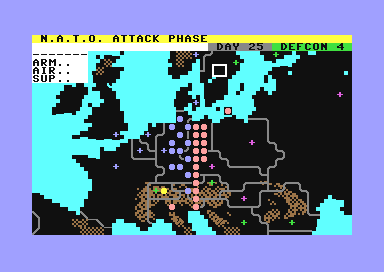 |
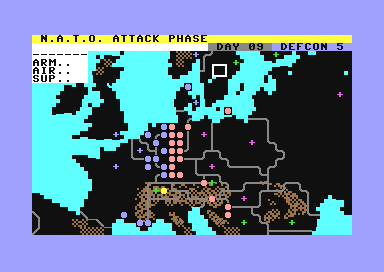 |
- Warsaw Pact strategy - If the player controls the Warsaw Pact, the computer will be very passive: it will never move or attack with Danish or Italian units; it will never advance; it will never attack any neutral unit; it will never swap two of its units; it will never move in diagonal; it will sometimes retreat in order to close a gap on its front, but won't if another of his units is behind; it will attack only if it has a certain strength superiority; it will attack one or two units just the turn prior of losing a game that it doesn't intend to stop with a total nuclear attack. Because the Warsaw Pact has more and stronger units, the best strategy for the player is to surround several of its units every turn, attack two or more points with several units at a time, make use of aerial bombing on vulnerable spots, and dispatch enemy units one by one. The player can and must send his units through the enemy gaps: if they are strong enough, they won't even be attacked. On the images below show a classic strategic enveloping maneuvre, at the beginning and the end of a campaign. If a unit becomes too weak to survive further battles, the player can just stop attacking with it or even break contact with the enemy by moving the damaged unit backward or sideways.
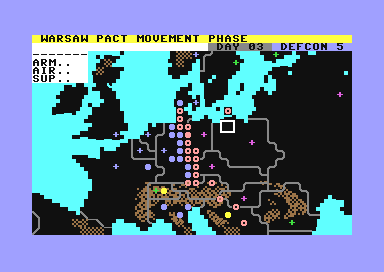 |
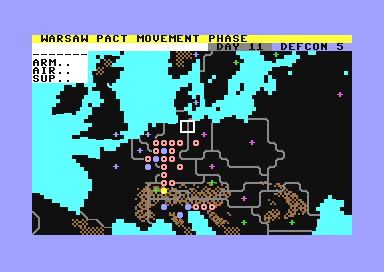 |
- Chemical release order - Because the Warsaw Pact relies on speed, it benefits for increasing casualties in battle, even if they are reciprocal. For NATO it's obviously the opposite. However, using chemical weapons increases the odds for the computer to launch a total nuclear attack, which is better to avoid. So the best option is to authorise chemical weapons only after the computer does.
- Bombing - If the player can bomb an enemy unit, is better to target a strong or an average one in order to soften it. Targeting a weak unit before it is attacked leads to overkill and waste of resources. With experience a player can tell what this game's units can and cannot do.
- Attack - The NATO player doesn't need to attack, except to get rid of the airborne unit after it landed behind his lines. There's no hurry, though. The player can take several turns to gather all his second class units and use them at once. The Warsaw Pact player has to constantly attack, but only with overwhelming numbers.
- Action screen - In order to beat the game in higher difficulties or even obtaining a good score, it's necessary to play the mini-game every turn and shoot many enemies.
- Rebuild - The NATO player should reinforce only his first line units. Eventually, if they are too strong, the computer won't attack them at all and the invasion will stall. If a front unit is badly damaged and in worse shape that a nearby second line unit, then the player should swap them and reinforce the new one. The Warsaw Pact player too should reinforce only his best units, and push aside those too badly damaged to continue the offensive. A unit with an armour level of 3 or 4 can usually sustain one more battle; one with a lower armour level will likely disappear on a battle. The player can also anticipate which units will soon be in a position to exploit a gap or envelop a flank, and reinforce them before it even happens.
- Air phase - A good strategy for the NATO player would be to strengthen the interdiction mission up to 10 units, and allocate the rest to air superiority, including the new planes delivered on next turns. A good strategy for the Warsaw Pact player would be to strengthen the assault-breaker mission up to 16 units, and allocate the rest to air superiority, including the new plans delivered on nest turns. It's important however, never to let the assault-breaker number fall under 10 all through the game. Deep-strike and iron-snake are very ineffective options. Reconnaissance is pretty useless too, because the starting strength of units is hard coded and doesn't change much through the game. With a little practice a player can remember by heart the various numbers.
- Special mission phase - It's quite easy to win the game without NBC weapons. In fact, the biggest obstacle to win the war is precisely the risk of escalation. So a good strategy is to never use first NBC weapons, and to keep the reflex system on to avoid sustaining alone NBC damage and exact revenge in case the computer launches a total nuclear attack.
Solution[edit | edit source]
There are four kind of endings:
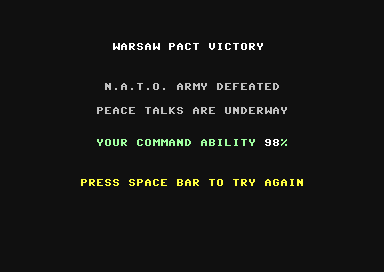 |
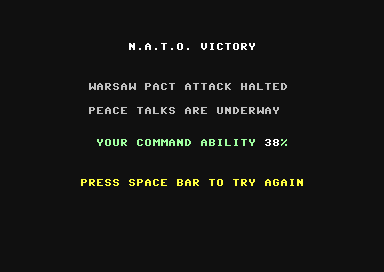 |
Cheats[edit | edit source]
Several crack versions are available on http://csdb.dk/.
Voting[edit | edit source]
| Voting of the C64-Wiki-User (10=the best vote): | ||
| 7.50 points at 20 votes (rank 258). You need to be logged in to cast a vote. | ||
| C64.com | 7 | 15th May 2018 |
| Lemon64 | 8.3 | 15th May 2018 - 44 votes |
| Kultboy | 8.75 | 15th May 2018 - 4 votes |
| Mobygames | 4.1 | 15th May 2018 - 5 votes |
Reviews[edit | edit source]
Lynx: "Nice game".
Notlob: "Ein vermeintlich langweilig wirkendes Spiel, welches allerdings für die damalige Zeit nahezu sensationell daher kam, da es möglich war, als "Warschauer Pakt" den "Westen" in Grund und Boden zu verdampfen! Das gab damals Auftrieb im Strickpulli-tragende-Lehrer Schulalltag :) Die Musik finde ich heute noch hörenswert und daher ist sie auch in meiner SidplayList."
Robotron2084: "This is NO exercise! Theatre Europe ist nicht zuletzt auch ein Zeitdokument aus der Übergangsphase vom Kalten Krieg in das Zeitalter der Perestroika. Eine an heutigen Maßstäben gemessen natürlich erschreckend simple KI, ein fehlender Zweispieler-Modus und eine mehr als undeutlich formulierte Anleitung lassen viele Wünsche offen. Dennoch ist das Spiel spannend, atmosphärisch unheimlich dicht und als Befehlshaber der NATO muss man sich schon ein wenig anstrengen, um hier den Sieg zu holen. Alles in allem ein Top-Spiel, obwohl es Hardcore-Strategen zu seicht vorkommen wird. Dennoch bestätigt sich hier, dass ein Gesamtprodukt deutlich mehr als die Summe der einzelnen Teile sein kann. Für Fans maximaler abstrakter Brutalität und Weltuntergangsjünger. 10 von 10 Punkten."
Blubarju: "Theatre Europe ist ein sehr übersichtlich aufgebautes Strategiespiel, was einen schnellen Einstieg ins Spiel garantiert. Mit den Action-Szenen konnte ich mich allerdings nie wirklich anfreunden. Aber man kann ja auch ohne spielen. Ich bin mir eh nicht sicher, wie groß der Effekt auf den Ausgang der Schlacht ist. Gute 8 Weltuntergangspunkte von mir. ;-)"
Miscellaneous[edit | edit source]
Awards[edit | edit source]
- In 1985 this game was awarded with the British Golden Joystick Award in the category Strategy Game of the Year.
Cover[edit | edit source]
 |
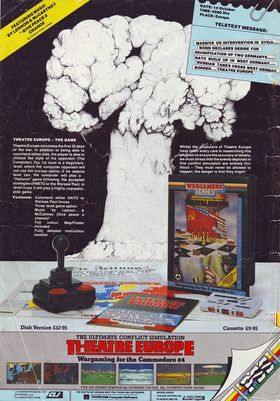 |
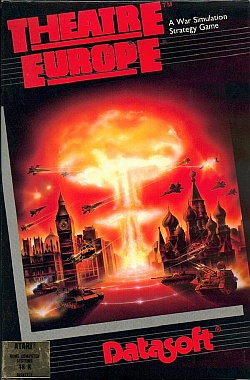 |
Advertisement[edit | edit source]
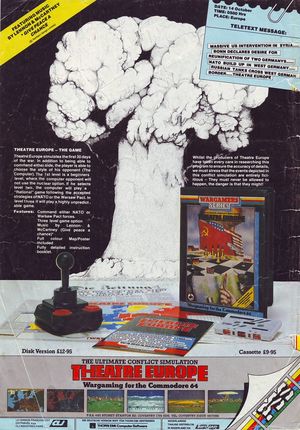 |
Highscore[edit | edit source]
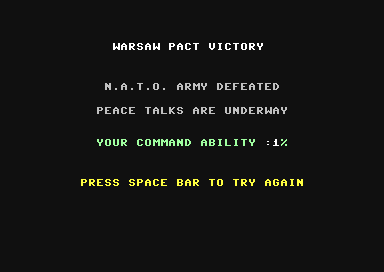
- Lynx - 101% Warsaw-Pact-Victory in 9 days - Level 3 (16.05.2018)
- calculon102 - 94% Nato-Victory (05.08.2010)
- Robotron2084 - 92% Nato-Victory (21.09.2007)
- Notlob - 90% Warsaw-Pact-Victory (28.02.2007)
- Blubarju - 85% Nato-Victory (30.04.2011)
Links[edit | edit source]
| Wikipedia: Theatre_Europe |
- C64Games.de - Game No. 731 (also manual in
 )
) - Lemon64 - Game No. 2632
- Gamebase64.com - Game No. 7869

- Gamebase64.com - Game No. 16705

- Gamebase64.com - Game No. 17541

- C64.com - Game No. 1404
- CSDb - Release No. 84342
- Test Report No. 1816 on Kultboy.com

- ZZap64 test report
- ZZap!64 [1]
- Gamebase
- Mobygames
- Remake at Nexus 23 Labs
